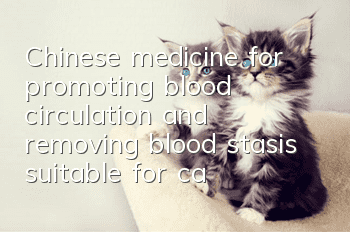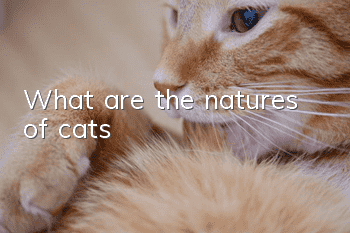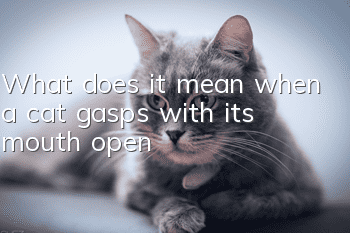Chinese medicine for promoting blood circulation and removing blood stasis suitable for cats

Cats often bump into each other at home or outdoors, and accidentally fall. If they fall, they will be bruised and bruised. Cats can rub some minor injuries on their own and tolerate them, but if they fall badly, they will be gone. If it's serious and you can't walk, then your Qi and blood are stagnant, and you need some drugs that can activate blood circulation and remove blood stasis to help treat it.
Of course, promoting blood circulation and removing blood stasis is not just for treating bruises. Cats will also suffer from blood stasis and abdominal pain and lumps after giving birth. They also need to activate blood circulation and remove blood stasis. In traditional Chinese medicine, there are many blood-regulating medicines that are also suitable for cats. Here are some Let me introduce a few to you.
1. Chuanxiong
Ligusticum chuanxiong is a cultivated plant mainly produced in Sichuan (Guan County). It grows in mild climate environments in Yunnan, Guizhou, Guangxi and other places. It is a traditional Chinese medicine plant that is often used to promote blood circulation and qi, dispel wind and relieve pain. Ligusticum chuanxiong is pungent, warm, fragrant and dry. It can be dispersed and can reach the top of the head when ascending; it also enters the blood and can reach the sea of blood when descending. It has a wide range of effects in promoting blood circulation and removing blood stasis, and is suitable for various diseases caused by blood stasis and stasis; it is very effective in dispelling wind and relieving pain, and can treat headaches, rheumatic arthralgia and other diseases. In the past, Ligusticum chuanxiong was said to be a medicine for qi in the blood, and it was almost said that it had the functions of pungent powder, relieving depression, improving circulation, and relieving pain.
Ligusticum Chuanxiong is mainly used to treat dystocia and retained placenta caused by qi and blood stasis. It is often combined with angelica, red peony root, peach kernel, safflower, etc., such as Taohong Siwu Decoction, or used to treat bruises in cats. It can be used with Angelica sinensis, safflower, frankincense, and myrrh are all equally useful.
Secondly, Ligusticum Chuanxiong can also dispel wind and relieve pain, and is used to treat symptoms caused by external wind and cold in cats. It is often used in the same way as Asarum, Angelica dahurica and Schizonepeta.
When using Ligusticum Chuanxiong, please note that Ligusticum Chuanxiong has an inhibitory effect on the brain, so you should pay attention to the dosage. It also has a paralyzing effect on the heart, and directly dilates blood vessels. Using a large amount of Ligusticum Chuanxiong can lower blood pressure. The general dosage for cats is 1 to 3 grams.
2. Salvia miltiorrhiza
Salvia miltiorrhiza is also known as red ginseng, red ginseng, purple salvia root, and purple salvia miltiorrhiza. It is the dried root and rhizome of the Lamiaceae plant Salvia miltiorrhiza. Mainly produced in Sichuan, Anhui, Jiangsu, Shandong, Hebei and other places. Cultivators in Long'an, Zhongjiang and other places in Sichuan often call it "Sichuan Salvia" because of its good quality. Medicinal material identification: The rhizome of this product is short and thick, and the stem base sometimes remains at the top. There are several roots, long cylindrical, slightly curved, some branched and with whisker-like thin roots, 10-20cm long and 0.3-1cm in diameter. The surface is brownish red or dark brownish red, rough, with longitudinal wrinkles. The outer bark of old roots is loose, mostly purple-brown, and often peels off in scales. The texture is hard and brittle, the cross-section is loose, cracked or slightly flat and dense, the bark is brown-red, the wood is gray-yellow or purple-brown, and yellow-white point-like vascular bundles can be seen, arranged in a radial pattern. The smell is slight and the taste is slightly bitter. The cultivated products are thick and plump, with a diameter of 0.5-1.5cm. The surface is reddish brown, with longitudinal wrinkles, and the outer skin is tight and not easy to peel off. The texture is solid, the cross-section is relatively flat and slightly horny. Those with thick strips and purple colorBetter.
Salvia miltiorrhiza has a miraculous effect on postpartum blood stasis in cats. It can be combined with peach kernels, safflower, angelica root, peony bark, and motherwort. It can also treat restlessness caused by internal heat in cats. It is often combined with Rehmannia glutinosa, Scrophulariaceae, Coptis chinensis, and Ophiopogon japonicus to eliminate febrile fever in cats and calm them down.
It is worth noting that Salvia miltiorrhiza also has a bactericidal effect and has inhibitory effects on Staphylococcus aureus, Vibrio cholerae, mycobacteria, Salmonella typhi, etc. The appropriate dosage for cats is 3 to 5 grams.
3. Sichuan Achyranthes
Also known as sweet achyranthes. It is the dry root of the plant Chuanniu Teng. The root bar is cylindrical, not twisted or slightly twisted; the root head is enlarged, the lower end of the root tapers, or there are a few small lateral roots, about 30 to 70 cm long and 1 to 2 cm in diameter. . The whole body has longitudinal wrinkles and traces of removal of lateral roots; the surface is brownish-yellow or black-gray. Tough and not easy to break. The cut surface is grayish-yellow to dark brown, with many light-colored dots visible, and oily substances precipitated, arranged in a ring of about 3 to 8 layers, with the one in the center being larger. It tastes sweet or slightly bitter and has no aroma.
Achyranthes Achyranthes has a strong effect in removing blood stasis and promoting menstruation. It is very effective in treating bruises, blood stasis, abdominal pain, and retained fetal membranes in cats. Achyranthes Achyranthes also has a diuretic effect and can be mixed with Qumai, talc, and mallow. Son compatibility.
- Are Turkish Van cats clingy?
- Is it true that cats have acne?
- How to tell if your cat has a fever or cold
- Oriental Shorthair Cat Appearance Characteristics_Personality Characteristics_Raising Methods
- Condition determines the price of Ragdoll cats
- How to care for your cat’s eyes
- Cat's soft stool has a little blood at the end
- Can male cats recognize their own babies?
- How long will a cat stay without litter?
- Can cats digest carbohydrates?



